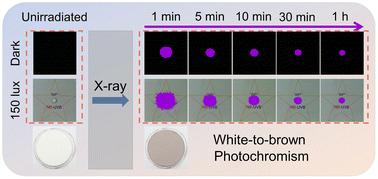当前位置:
X-MOL 学术
›
Inorg. Chem. Front.
›
论文详情
Our official English website, www.x-mol.net, welcomes your
feedback! (Note: you will need to create a separate account there.)
A narrowband ultraviolet-B-emitting LiCaPO4:Gd3+ phosphor with super-long persistent luminescence for over 100 h
Inorganic Chemistry Frontiers ( IF 6.1 ) Pub Date : 2024-10-23 , DOI: 10.1039/d4qi02407a Xihui Shan, Xulong Lv, Dongxun Chen, Yi Zhang, Lixin Ning, Yanjie Liang
Inorganic Chemistry Frontiers ( IF 6.1 ) Pub Date : 2024-10-23 , DOI: 10.1039/d4qi02407a Xihui Shan, Xulong Lv, Dongxun Chen, Yi Zhang, Lixin Ning, Yanjie Liang

|
The past decades have witnessed a significant increase in interest in inorganic luminescent materials that emit in the narrowband ultraviolet-B (NB-UVB; 310–313 nm) spectral region due to the growing need for applications in photochemistry and photomedicine. However, the majority of existing NB-UVB phosphors rely on photoluminescence, which requires constant external excitation. This common but inconvenient photoluminescence style significantly slows down the progress of NB-UVB luminescence technology. Herein, we report the design and synthesis of a new Gd3+-doped NB-UVB-emitting persistent phosphor, LiCaPO4:Gd3+, which shows strong NB-UVB persistent luminescence peaking at 312 nm and a super-long persistence time of >100 h after ceasing X-ray excitation. Owing to the zero-background noise from the ambient light, a UVB camera can detect the NB-UVB light emission originating from the charged LiCaPO4:Gd3+ phosphor in a bright indoor environment. Through spectroscopic investigations and first-principles calculations, the nature of energy traps and the persistent luminescence mechanism of Gd3+ in the LiCaPO4 host have been thoroughly studied. Besides, remarkable photochromic behavior when irradiating the phosphor with X-rays is also observed, and the possible intrinsic point defects that contribute to the colorization are proposed. This NB-UVB persistent phosphor shows great potential in indoor optical tagging, optical information storage, and dermatological therapy.
中文翻译:

一种窄带紫外 B 发射 LiCaPO4:Gd3+ 荧光粉,具有超长持续发光时间超过 100 小时
由于对光化学和光医学应用的需求不断增长,过去几十年来,人们对在窄带紫外 B (NB-UVB;310-313 nm) 光谱区域发射的无机发光材料的兴趣显著增加。然而,大多数现有的 NB-UVB 荧光粉都依赖于光致发光,这需要持续的外部激发。这种常见但不方便的光致发光方式显着减慢了 NB-UVB 发光技术的进步。在此,我们报道了一种新的 Gd3+ 掺杂 NB-UVB 发射持久性荧光粉 LiCaPO4:Gd3+ 的设计和合成,它在 312 nm 处显示出强烈的 NB-UVB 持续发光,在停止 X 射线激发后具有 >100 h 的超长持久性时间。由于环境光的背景噪声为零,UVB 相机可以在明亮的室内环境中检测来自带电的 LiCaPO4:Gd3+ 荧光粉的 NB-UVB 光发射。通过光谱研究和第一性原理计算,已经彻底研究了 LiCaPO4 宿主中能阱的性质和 Gd3+ 的持续发光机制。此外,在用 X 射线照射荧光粉时还观察到显着的光致变色行为,并提出了可能导致着色的内禀点缺陷。这种 NB-UVB 持久性荧光粉在室内光学标记、光学信息存储和皮肤病治疗方面显示出巨大的潜力。
更新日期:2024-10-23
中文翻译:

一种窄带紫外 B 发射 LiCaPO4:Gd3+ 荧光粉,具有超长持续发光时间超过 100 小时
由于对光化学和光医学应用的需求不断增长,过去几十年来,人们对在窄带紫外 B (NB-UVB;310-313 nm) 光谱区域发射的无机发光材料的兴趣显著增加。然而,大多数现有的 NB-UVB 荧光粉都依赖于光致发光,这需要持续的外部激发。这种常见但不方便的光致发光方式显着减慢了 NB-UVB 发光技术的进步。在此,我们报道了一种新的 Gd3+ 掺杂 NB-UVB 发射持久性荧光粉 LiCaPO4:Gd3+ 的设计和合成,它在 312 nm 处显示出强烈的 NB-UVB 持续发光,在停止 X 射线激发后具有 >100 h 的超长持久性时间。由于环境光的背景噪声为零,UVB 相机可以在明亮的室内环境中检测来自带电的 LiCaPO4:Gd3+ 荧光粉的 NB-UVB 光发射。通过光谱研究和第一性原理计算,已经彻底研究了 LiCaPO4 宿主中能阱的性质和 Gd3+ 的持续发光机制。此外,在用 X 射线照射荧光粉时还观察到显着的光致变色行为,并提出了可能导致着色的内禀点缺陷。这种 NB-UVB 持久性荧光粉在室内光学标记、光学信息存储和皮肤病治疗方面显示出巨大的潜力。


















































 京公网安备 11010802027423号
京公网安备 11010802027423号